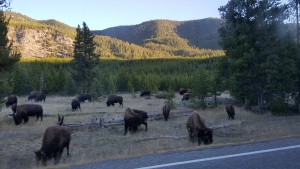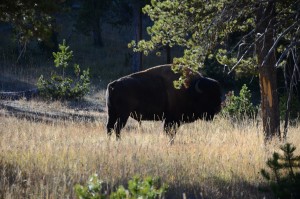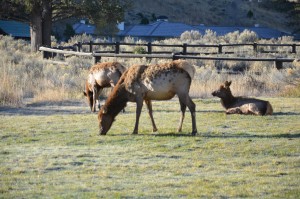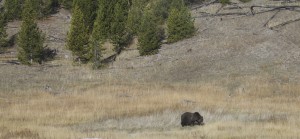
Bears, bison park’s most popular animals
WEST YELLOWSTONE, Mont. — E.O Wilson and David Quammen, along with countless other prominent ecologists, conservationists, and population geneticists have been trying to understand animal populations throughout history and help preserve animal populations today.
What all the science seems to eventually point to is this: all efforts of conservation will likely be futile if an insufficient amount of habitat is given to hold a large group of animals of multiple species. With that in mind, it would come as no surprise that Yellowstone National Park boasts a tremendous array of mammals and birds both massive and minuscule.
There are more than 50 species of mammals in Yellowstone ranging from tiny underground shrews to herds of giant elk. The park’s visitor center, along with the website, both list wildlife viewing as one of the most common activities visitors undergo, and speculate that these animals could be the main reason visitors decide to make their trip happen.
With 2015’s visitor count very close to four million people for the first time in history, that means that these animals are an integral aspect of the park. The signs and souvenirs around the park leave no mystery as to what animals are most likely behind visitors’ immense zoological awe: Bison and bears.
It does not take a zoologist to attest to the health of Yellowstone’s bison population: they are everywhere. According to the park’s “Mammals in the Park” pamphlet, Yellowstone alone (as opposed to the greater Yellowstone region) is home to more than 3,500 bison.
These hooved beasts may move slowly in herds as they graze the park’s open meadows and grasslands, but they can turn any head just by their sheer size. Bison are the largest land mammal in the park and on the continent. Males (called bulls) can weight up to 1,900 pounds when fully grown.
 |
Bison graze early in the morning. This herd was seen on the Loop Road through West Thumb in the park (Photo by Marwan Alenezi). |
Seeing them in the hundreds, as we did in October, is truly a sight to behold. They have chocolate-brown coats, long thin ‘beards’ and thick but short horns. No view of the Yellowstone landscape is complete without a massive grazing bison in the frame. Their shoulder humps peak at around six feet high and, for heavy herbivores, they run fast. These animals can reach speeds of 35 miles an hour.
Coupled with a random aggressive outburst, it suddenly makes sense why the park’s law requires that viewers must stay at least 100 yards from these docile looking ungulates (hooved mammals).
At the Old Faithful Geyser Visitor Center, Rebecca Roland, a ranger with 15 years of work experience under her belt both at Yellowstone and other parks, works at the Information Desk. She has spent her fair share of time with bison.
“We babysit bison calves when needed and, as you probably saw, they’re very common,” she noted.
She currently works more with visitors than animals, but on organized hikes, tours and walks she constantly reminds people “bison have been more dangerous to humans than bears and wolves combined in this park, by far. Just this summer (June-August 2015) we’ve had five gorings, which is unfortunate to say the very least.”
The Yellowstone bison population has been doing very well and it’s really is a sight to behold, considering that the species was nearly obliterated due to hunting in the late 1800s.
 |
A bison stands among trees near Old Faithful (Staff photo). |
At one point, there were less than 2,000 bison in the country, mostly because hunting them had many reasons and benefits, from collecting hide to food to sport. The population was carefully nursed back to health. In fact, it was so successful that even today there are enough of them to supply many states with their meat. Most food venues in and around Yellowstone served country-fried bison steak or, more commonly, bison bratwurst.
While the park website, rangers and visitor centers all offer information regarding where to find certain types of animals, either with maps, checklists or books, bison are legitimately found in almost any part of the park.
While we saw most on the side of the road while driving along the Grand Loop Road of the park, also known as the Upper Loop and Lower Loop roads, the most scenic site to see them is probably Hayden Valley, on the Lower Loop south of Canyon Village.
That’s where some of the largest herds are, and therefore increases the chances of seeing bulls, cows, and calves all together. Visitors must remember that these animals are incredibly quick; as well they should be with their predators not too far away.
Bears are easily the most anticipated and exciting animals in the park. The park has two species: the black bear and the grizzly bear. Both are large, but a big grizzly bear could be one and a half times as big as a black bear.
 |
Elk graze near the Albright Visitor Center at Mammoth Hot Springs (Staff photo). |
Omnivorous animals, bears are one of the animal kingdom’s most diverse members. They sprint, climb, swim, dig, jump, and sleep for months during the winter. They eat fish, deer, hares, berries, plants and even termites. Second only to their polar counterparts, grizzly bears are North America’s largest meat eaters.
Park rangers estimate that there are anywhere between 280 to 610 grizzlies in the park, and only a few dozen more black bears. Reading that while on a camping trip or guided tour might be disheartening to avid nature goers bent on snagging a photo of a bear, but luckily for us we managed to see a fully grown grizzly just more than 100 yards away from us.
A small stream between us (and other photographers) kept a visual barrier between us and the animal, yet our conversations behind the lenses were very similar: “You know he can be here in 20 seconds flat if he wanted to, right?”
Grizzly bear populations have slowly been on the rise and Amy Bartlett, a park ranger for 21 years, said that they are the park’s least common animals. And yet, during our meeting at the park headquarters, Bartlett, the Yellowstone media spokesperson, confidently pointed to a “Mammal Map.”
“Lamar Valley is your best bet. Mount Washburn has a few resident bears that are sighted in the summer like clockwork, but for visitors staying only two or three days, Lamar Valley is the wildlife spot,” she explained.
While we did not have enough time to make it to Lamar Valley, we still saw one black bear and one grizzly bear. The black bear was spotted just a few minutes after driving into Mount Washburn and the grizzly just before we reached Old Faithful geyser. This attests to the health of the population of these animals, which aren’t only endangered, but are large apex predators at the top of the food chain.
 |
A mature grizzly bear foraging beside the Loop Road near Old Faithful Geyser (Photo by Marwan Alenezi). |
Trent Redfield, a bear specialist at the Grizzly and Wolf Discovery Center in West Yellowstone, spoke passionately about the natural prowess of these animals. “Even compared to similar animals, on land or in the sea, few can match a mature grizzly. They’re a scientific wonder…their senses are just as accurate and keen as their physical structure is large and powerful. Many even argue that bear spray is only as effective as it is because of how sensitive their noses are.”
Biologically speaking, North America is not the most diverse continent, meaning it doesn’t have the highest number of different species. But ecologists and biologists know that that isn’t what matters alone.
North America has massive animals, and this land remains a gold mine for bio geographers and population geneticists alike. Even without the science jargon or context, the animals here are massive and rugged enough to be considered part of the landscape, and beautiful enough to be considered as a sight of their own.
A rich part of the park’s history has been its fauna, a dangerous part of their history about over-hunting, and an inspiring part of their present is their conservation for generations to come.
If You Go
Prime spots and times:
- Grizzly and black bears: Early to midday at Mount Washburn and Lamar Valley.
- Wolves: Dawn at Hayden Valley and Lamar Valley.
Bison: Early morning until dusk at Hayden Valley, Lamar Valley, and West Thumb.
If driving, it’s best to enter from the northeast entrance and head east to Lamar Valley at dawn and continue on the Grand Loop Road.

Comments are Closed